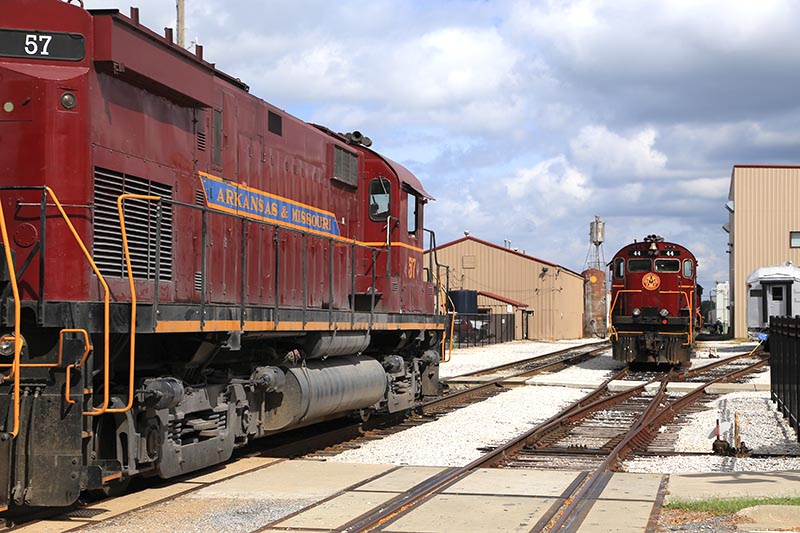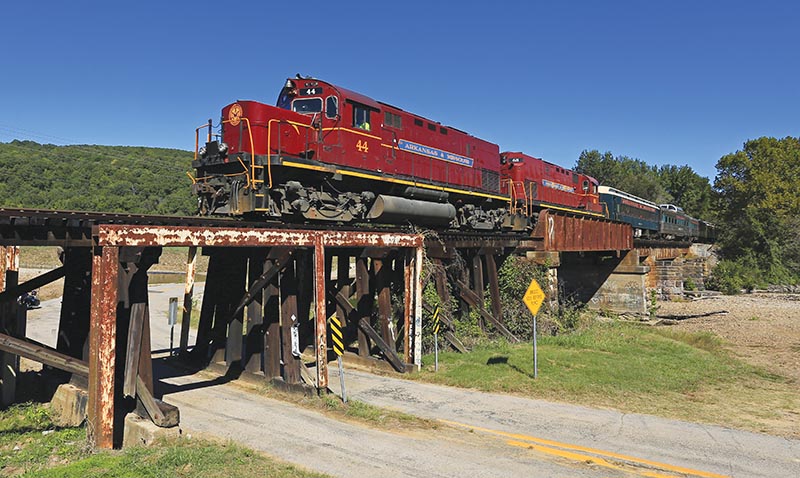 By Steven McKay/photos by the author
By Steven McKay/photos by the author
In the 1980s and 1990s, Arkansas & Missouri Railroad became a major destination for railroad enthusiasts looking to enjoy the sights and sounds of American Locomotive Co. products hauling heavy freights through the heart of the Ozarks. A&M was established in 1986 to operate 150 miles of former St. Louis-San Francisco Railway (better known as Frisco) main line between Monett, Mo., and Fort Smith, Ark. The star of the show was a fleet of Alcos, mostly C-420s, wearing a smart-looking maroon, blue, and yellow livery.
Almost 35 years after its creation, A&M is busier than ever, and despite the acquisition of three EMD SD70ACe locomotives, the railroad’s Alcos are still chugging through the Ozarks daily.
When the railroad purchased the SD70ACe demonstrator units from EMD in 2013, many believed A&M was on the cusp of replacing the Alcos. But seven years later, the three six-axles are the only EMDs the road has purchased, mostly for its road freight. While the days of five- and six-unit C-420 consists are most likely over, the visiting railfan can still find up to 10 different Alcos working on various locals out of Springdale or Fort Smith, Ark., and on seasonal excursion trains. In hopes of seeing what Alcos remained, I headed to the Ozarks in October 2018 for a look at one of the last great bastions of Schenectady power in North America. What follows is a rundown of what typically happens on this still-exciting regional railroad.

With work complete at the George’s Prepared Foods feed mill on October 8, 2018, the Springdale Switcher passes the company’s offices, locomotive shops, and a set of C420s that will be used for the passenger train later that morning.
Springdale in the Morning
I started most days on the railroad in the early morning hours at the Springdale shops, where the railroad’s fleet of Alcos is maintained. Besides the three EMD SD70ACe locomotives, A&M still rosters a number of C-420s, C-424s, a T-6, an RS-32, and an RS-1. By the time I arrived, the Alcos were peacefully idling waiting for their morning assignments. Crews based in Springdale report to the office and shops Monday through Friday for the Sand Switcher (on duty 7:00am), Monett Turn (7:30am), Rogers Local (8:30am), and the Springdale Switcher (10:00am). On select days, another crew is called for a passenger excursion.
The first job to depart the yard will be the remote-controlled Sand Switcher. The job typically uses A&M 32, an Alco C-424 built as Belt Railway of Chicago 601 and the only one of its model on the active roster. After going on duty, the Sand Switcher will depart the shops and head to a small yard on the north side of Springdale to grab a cut of sand cars, usually set out the night before by the Fort Smith Turn and destined for the five different transload facilities between Springdale and Rogers, Ark. On heavy days, a second, extra Sand Switcher will handle the facilities around Rogers utilizing another Alco. Construction-grade sand is the railroad’s most common commodity; the sand originates at a barge-to-rail transload in Van Buren on the Arkansas River and is delivered to various points from Van Buren to Monett, with the majority of the sand being set out in Springdale.

Doing every bit of track speed, the passenger train cruises above the gentle and very clear, teal-colored Frog Bayou on October 11, 2018.
The next train to depart is the Monett Turn that will typically use the EMD SD70ACe locomotives. The Monett Turn handles interchange traffic with BNSF Railway at Monett, as well as sand to be set out between there and Rogers on the trip north. The Monett Turn crew usually makes quick work of getting its train together and departing north.
Once the Monett Turn is out of town, the Rogers Local begins switching the yard on the north side of Springdale. The Rogers Local spends a few hours switching and building its train before departing north for Rogers, typically sporting a single C-420. Once it has departed Springdale, the Rogers Local will spend most of its day working in the vicinity of Rogers, including a branch line that runs to Bentonville, Ark.
While the Rogers Local is busy building its train in Springdale, the Springdale Switcher arrives shortly after 11:00am. The Springdale Switcher will work in tandem with the Rogers Local to build both trains. The Springdale Switcher is responsible for working a large number of customers throughout the greater Springdale area and typically sports a pair of well-maintained C-420 locomotives. If time and customer needs permit, the train will make the short run to Fayetteville, Ark., before tying up at the shops in Springdale. The job is typically drilling cars and switching customers for the whole day and tying up just short of a full 12-hour day.
All of these jobs out of Springdale offer many photo opportunities, whether you want to chase Alcos hauling freight all day, give chase to the trio of matching SD70ACes or, if you are feeling ambitious, shoot a combination of all the jobs. Regardless of what you pick, you won’t regret it…



